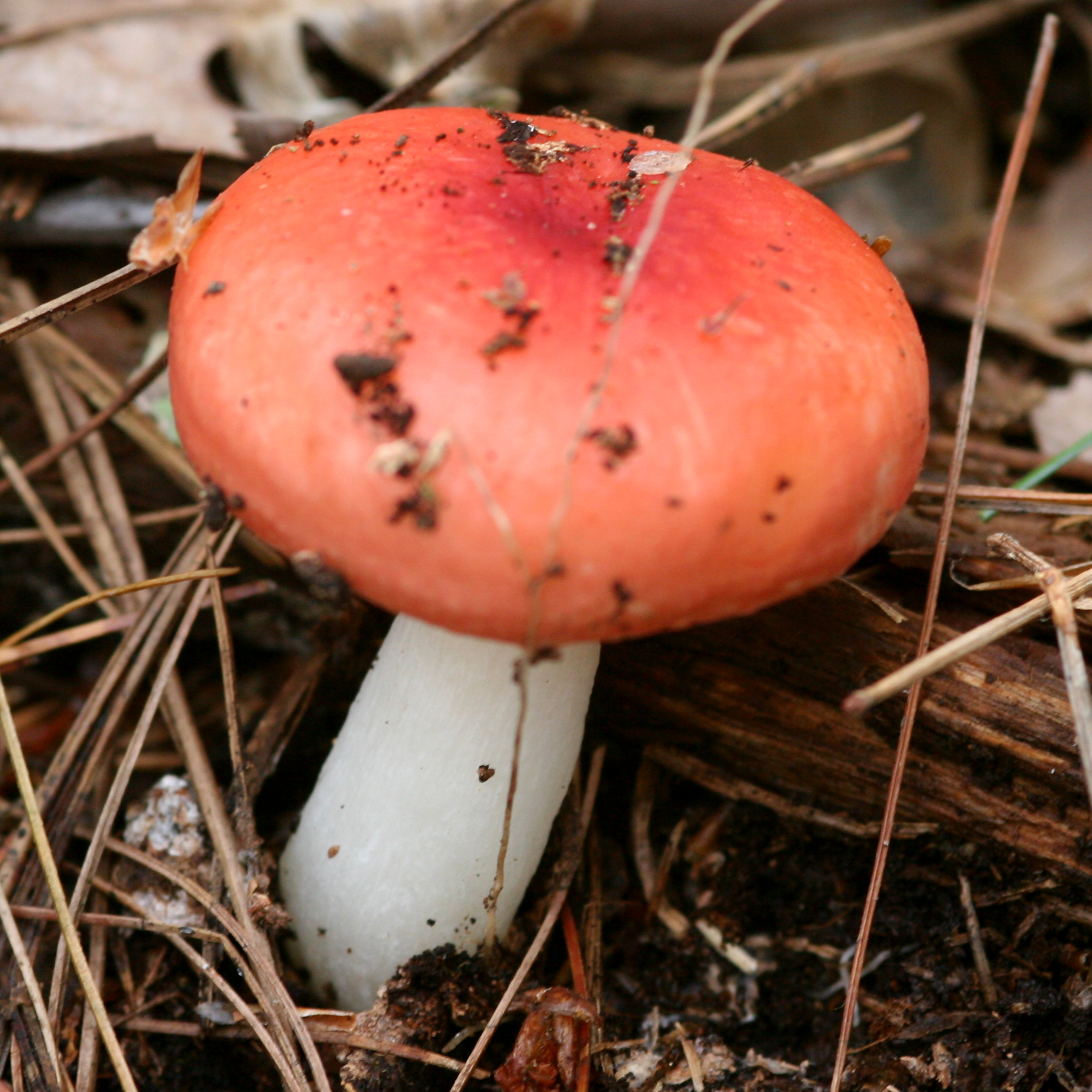- Russula emetica
Taxobox
color = lightblue
name = "Russula emetica"
status =
image_width = 200px
regnum = Fungi
divisio =Basidiomycota
classis =Homobasidiomycetae
subclassis =Hymenomycete s
ordo =Russulales
familia =Russulaceae
genus = "Russula "
species = "R. emetica"
binomial = "Russula emetica"
binomial_authority = (Schaeff.: Fr.) Pers. mycomorphbox
name = Russula emetica
whichGills = free
capShape = convex
hymeniumType=gills
stipeCharacter= bare
ecologicalType=mycorrhizal
sporePrintColor=white
howEdible=poisonous"Russula emetica", commonly known as The Sickener, is a
basidiomycete mushroom of the genus "Russula ", one of many species with a predominantly red-coloured cap and white gills and stalk. It gets its common name from its inedibility, as it causes vomiting and diarrhea when consumed. It has an extremely peppery taste, which is said to disappear on cooking, along with its toxicity, though eating it is not recommended.Taxonomy
"R. emetica" was first described as "Agaricus emeticus" by Jacob Christian Schaeffer in 1774, [In Schaeffer's series on fungi of Bavaria and the Palatinate, " Fungorum qui in Bavaria et Palatinatu circa Ratisbonam nascuntur icones." published since 1762.] before being placed in the new genus "Russula" by
Christian Hendrik Persoon in 1796, where it remains. Its specific epithet is derived from theAncient Greek "emetikos"/εμετικος 'emetic' or 'vomit-inducing'.cite book | author = Liddell, Henry George and Robert Scott | year = 1980 | title =A Greek-English Lexicon (Abridged Edition) | publisher =Oxford University Press | location = United Kingdom | id = ISBN 0-19-910207-4] Similarly, its common names of "sickener", "emetic russula" and "vomiting russula" also refer to this attribute.The uncommon European subspecies "R. emetica longipes" is distinguished by its longer stalk and ochre-coloured gills. The paler European mushroom "
Russula betularum " of coniferous forests and moorland is sometimes considered a subspecies.Description
The sticky cap is 3-10 cm (1¼-4 in) wide and a bright scarlet or cherry red in colour with finely ridged margins. It is initially convex, then later flat, or depressed. The brittle flesh is white and the taste is very sharp and peppery. The
spore print is white, as are the narrowly spaced gills. The stipe is up to 7 cm (3 in) long and 1 cm (½ in) wide, cylindrical and white.cite book | author = Carluccio A | year = 2003 | title = The Complete Mushroom Book |pages=p. 71| publisher = Quadrille | id = ISBN 1-84400-040-0] The fungus has an unusual fruity smell.It is one of many red-coloured species of "Russula"; the related Beechwood Sickener ("R. nobilis") is found under beech in Europe. Many, such as the paler "R. sanguinaria", are inedible, though "R. aurea" is edible and good: it has a yellow stem, gills and flesh under its red cap. [cite book | author = Nilson S & Persson O | year = 1977 | title = Fungi of Northern Europe 2: Gill-Fungi | publisher = Penguin|isbn=0-14-063006-6|pages=p. 118] Another inedible species, "R. fragilis" has notched gills, and its stalk stains blue with
naphthol .cite book|author=Zeitlmayr L|year=1976|title=Wild Mushrooms:An Illustrated Handbook|publisher=Garden City Press, Hertfordshire|isbn= 0-584-10324-7|pages=p. 92] The red pigments of this and other russulas are water soluble to some degree, and fruiting bodies will often bleach or fade with rain or sunlight.cite book | author = Ramsbottom J | year = 1953 | title = Mushrooms & Toadstools|pages=p. 102 | publisher = Collins | isbn = 1870630092]Distribution and habitat
The Sickener may be found in wet places in
coniferous woodlands in Europe, North Africa, Asia and North America, and can be very common.cite book | author = Kränzlin F | year = 1991 | title = Fungi of Switzerland 6: Russulaceae|pages=p. 164 | isbn = 3-85604-260-1] There is some doubt over the extent of its range in North America, as some sightings refer to the related "Russula silvicola "; initially the name "Russula emetica" was often applied to any red-capped white russula encountered. Sightings in Australia are now referred to the similarly coloured "Russula persanguinea ".Toxicity
As its name implies, the Sickener is poisonous, though not as dangerous as once described in older mushroom guides. The symptoms are mainly gastrointestinal in nature:
diarrhoea , vomiting andcolic ky abdominal cramps. The active agent has not been identified but thought to besesquiterpene s, which have been isolated from the related genus "Lactarius " and from "Russula sardonia ". [cite book |last=Benjamin| first= Denis R. |title=Mushrooms: poisons and panaceas — a handbook for naturalists, mycologists and physicians|pages=p. 369|publisher=WH Freeman and Company| location=New York |year=1995| isbn=0-7167-2600-9]The bitter taste does disappear on cooking and it is said to be edible, though not recommended. A study in England and southern Scotland found that the
Red Squirrel ("Sciurus vulgaris") is known to forage for, store and eat the Sickener. [cite journal|author=Lurz PWW, South AB |year=1998|title=Cached fungi in non-native conifer forests and their importance for red squirrels ("Sciurus vulgaris" L.) |journal=Journal of Zoology, London |volume=246|pages=468–71|doi=10.1111/j.1469-7998.1998.tb00184.x]External links
*http://botit.botany.wisc.edu/toms_fungi/sep2004.html Tom Volk's page on Russula emetica
References
* "Danske storsvampe. Basidiesvampe" [a key to Danish basidiomycetes] J.H. Petersen and J. Vesterholt eds. Gyldendal. Viborg, Denmark, 1990. ISBN 87-01-09932-9
Wikimedia Foundation. 2010.

